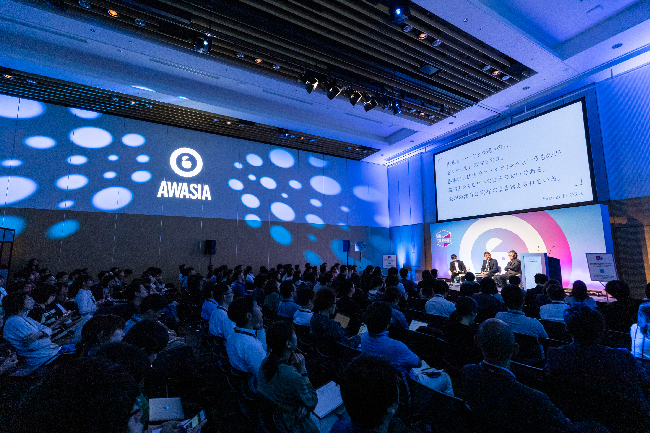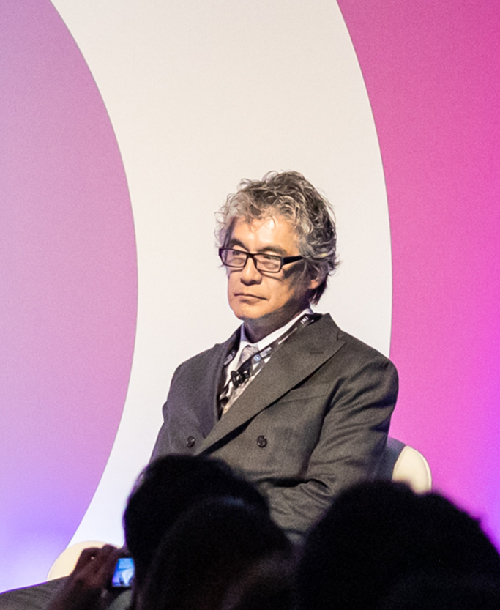The global marketing and communications event, "ADVERTISING WEEK ASIA 2019," was held at Tokyo Midtown from May 27 to 30. The venue brought together leaders from around the world across diverse fields—including brands, media, and technology—under a wide range of themes, hosting various sessions.
One session, titled "The Creativity We Must Capture Now Lies Right Next to Scientific Thinking," featured Yuichi Washida (Professor, Hitotsubashi University Graduate School), who researches innovation and future insight methodologies; Yasumichi Oka (Representative, TUGBOAT), a top creator in Japan's advertising industry; with moderator Shinya Tanaka (Director, Dentsu Inc. Isobar), who possesses extensive mass branding experience and expertise in cutting-edge digital marketing.
The discussion unfolded based on transcripts from interviews Tanaka had conducted beforehand with Washida and Oka. Under the question "How can we trigger human creativity?", they explored the ideal state of marketing and creativity.
To traverse the boundlessly expanding horizons of marketing
Tanaka: "I believe modern marketing is characterized by the fact that while everyone speaks as if they understand everything, no one truly comprehends it all." Digital technology has further expanded this horizon. The starting point for this session shares the same core concern as a passage from Professor Washida's book, 'Thinking Methods for Future Insight'.
It states: "Modern corporate management and marketing methods, in their pursuit of efficiency and productivity, have become remarkably indifferent to issues of creativity and cultural significance. (...) In such a management environment, there is even an atmosphere where it is difficult to propose the importance of cultural values and creativity, or the resolution of social problems."
At Dentsu Inc. Isobar, we consciously avoid over-relying on left-brain thinking in our daily work. Yet, we felt it necessary to pause and reconsider: without using digitalization as an excuse, from what perspective should creativity be expressed? We hoped this would offer insights for planning work and everyone involved.
Professor Washida has explored this in his writings and prior interviews using the terms "cause" and "effect." "Cause" refers to pre-campaign validation, marketing hypotheses, and data; "effect" refers to the campaign's actual results. He found some interesting research findings in this area.
Washida: That's right. For instance, even after formulating hypotheses or conducting pre-verification, the expected results aren't always achieved. Also, even when listing probable causes for a campaign's success based on marketing statistics, the creator's proposal—often unrelated to those causes—proves correct with surprising frequency. It's a phenomenon where "the cause is wrong, yet the result is right." These occur frequently in advertising work.
Through continued research, I've come to understand that, beyond marketing statistics, having an extensive, well-researched understanding of the underlying causes is crucial for campaign success. Creators and designers are also extremely eager to accumulate knowledge about the causes of phenomena happening in the world. "What's the intent behind this design?" "Why does this interesting phenomenon occur?" and so on...
Even if you can't always verbalize or systematize it, possessing an immense knowledge of causal factors means that when you're asked for an answer in your work one day, you can make an educated guess about where the cause lies. This is purely "tacit knowledge," but I believe it's a tremendous human capability.
Tanaka: The idea that humans possess "tacit knowledge" is incredibly encouraging for creators. Mr. Oka, how does this play out in real creative work?
Oka: For example, suppose there's a product that isn't selling well, and we need to launch an ad or campaign to spark public interest. During the orientation, the client presents marketing hypotheses and data. If we simply trace the client's hypotheses and present, "This is how we'd express that," I believe we're abdicating our responsibility as creators.
There must be many reasons the product isn't selling beyond the hypotheses presented in the orientation. The job of a creator is to consider all possible causes, including the "tacit knowledge" Professor Washida mentioned—the various factors creators intuitively grasp in their daily work—and to make a leap in expression.
Currently, there's too much focus on marketing-driven, left-brain thinking in "expression," which results in a lack of persuasiveness. When I collaborate with marketers, I don't start with survey results or pre-existing hypotheses. Instead, I present creative ideas first and then develop the strategy through discussion with the marketing team.
Tanaka: As Mr. Oka says, if we just trace what's been built by the left brain, the very reason for our existence as creators disappears.
Both advertising and future insights are always guided by the right brain.
Tanaka: When I asked Mr. Oka, "If you were to return to Dentsu Inc. now as a Creative Director, what would you tell young planners first?", he replied, "I'd tell them to make ads that stand out. Otherwise, it's inefficient."
Right now, in another session at this venue, they're discussing how to boost advertising efficiency through technology. Amidst that, I think his words are fundamental and bring us back to basics.
Oka: In my work, I rely solely on my right brain. I believe you simply can't create "eye-catching ads" without it. Fundamentally, no matter what marketing hypothesis you base an ad on, if it doesn't stand out, it's inefficient. When explaining to clients, I naturally organize my thoughts with my left brain and present logically...
Sometimes it might seem like a subjective opinion, but creators possess a certain objective judgment criterion based on the "tacit knowledge" accumulated over many years.
Washida: I believe the success or failure of a project hinges on whether we can look beyond what marketing identifies as the cause and instead focus on the various causes accumulated within the individual, and then accept the ideas that emerge from that.
Tanaka: If you can't accept such ideas, constantly doubting and analyzing them with your left brain, the answers become boring. So, believe and try. Thinking this way, even within the process of unleashing creativity itself, you must constantly question, "Is this approach correct?" Following the usual process will only yield the usual results.
Washida: In my research on future foresight, I also hold the view that basing ideas on a "narrow causal law" – imagining only one future for a single event – diminishes the ability to predict the future, no matter how compelling the hypothesis.
For example, in the automotive industry today, "autonomous driving" is a major topic. However, it's crucial to envision not just "a future where fully autonomous driving is widespread," but also "a future where autonomous driving never catches on" or "a future where autonomous driving is used in completely different ways."
Tanaka: Future prediction creativity mustn't just trace what the left brain has conceived. Mr. Oka once said that outstanding advertising expressions contain "unexpected yet correct answers." Merely tracing left-brain concepts leads to "misguided predictability."
What matters is whether we can believe in and unleash the individual's "accumulation" and "tacit knowledge" born from trial and error, as Professor Washida suggests. Today, everything is personalized, yet the joy of serendipity is fading.
To spark strong creativity, I believe it's also vital to pause and reflect.











